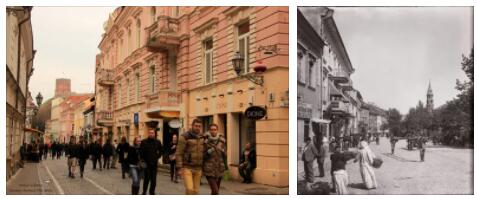First settlers
First people settled around 12,000 BC. In the area that is today Lithuania. Different cultures developed.
From around 4000 BC, hunters and gatherers became Settled farmers.
The Balts probably came in the 3rd millennium BC. In their current settlement area and merged with the people living there.
From around AD 1000, the Baltic tribes emerged, including the Lithuanians.
Who was Mindaugas?
Mindaugas founded the Lithuanian state by uniting five principalities. He was first ruler of a Lithuanian principality and then subjugated the other principalities. To this day he is revered as a national hero in Lithuania. In 1253 he was even crowned King of Lithuania by the Pope.
Advancing knights of the Teutonic Order were successfully resisted in the 14th century. At the same time, the empire slowly expanded to the east.
Grand Duchy of Lithuania
In the 14th century Lithuania rose to become a major power in Eastern Europe. In 1323 Prince Gediminas founded the capital Vilnius. He became one of the great rulers of Lithuania. Belarus and parts of today’s Ukraine and western Russia were under Lithuanian rule.
After the Grand Duke Algirdas, his son Jogaila came to power in 1377. He married Hedwig, who was to take over the royal throne in Poland, and converted to Christianity. This is how he received the Polish royal crown. From 1385, Lithuania and Poland were ruled by one king in personal union. Jogaila founded the ruling house of the Jagellions.
The Lithuanian nobility came under Polish influence over time and adopted the culture and language of Poland. Lithuania remained Catholic during the Reformation – like Poland – and did not become Protestant like the northern Baltic States, which were under German influence.
Poland-Lithuania and Russian rule
In 1569 the two countries united to form Poland-Lithuania. Lithuania sought support in the war against Russia. Poland now gained even more political upper hand. In the struggle for power, however, Poland lost to Russia at the beginning of the 18th century.
Poland was divided three times and in 1795 the Lithuanian territory finally came to Russia. Two uprisings in 1831 and 1863 were bloodily suppressed. Russian became the language of instruction, texts could only be printed in Cyrillic.
History of Lithuania from the 20th century until today
Independent Lithuania (1918-1940)
The rule of the tsars in Russia ended with the February Revolution in 1917, and in October the Communists, the Bolsheviks, took power. Their Red Army also fought to take over power in Lithuania, but – unlike in Ukraine or Belarus, for example – they could be defeated.
As a country beginning with L according to Countryaah, Lithuania became an independent republic. The first president was Antanas Smetona, but only for one year. In 1922, a new constitution was adopted under which Lithuania was a parliamentary republic. In 1926, Smetona came to power with the help of the military. He established a dictatorship modeled on Italian fascism.
In 1940 the Soviet Union increased its pressure. Smetona abdicated. Soviet troops marched in and installed a new government which declared it would join the Soviet Union.
German occupation (1941-1944) and part of the Soviet Union (1940-1990)
During the Second World War, Lithuania was occupied by German troops in 1941. Almost the entire Jewish population was murdered in the next few years.
In 1944, Soviet troops recaptured the area. The Lithuanian Soviet Socialist Republic was re-established. Resistance was brutally suppressed by Stalin’s henchmen. Tens of thousands were deported to Siberia and put in prison camps. All the measures that were carried out in the Soviet Union also took place in Lithuania, such as the collectivization of agriculture. That meant the amalgamation of individual farms to form large cooperatives. The farmers lost their property.
Independence 1990
A strong independence movement began in Lithuania as early as the late 1980s. One also speaks of the Singing Revolution in the Baltic States. People sang their own songs at gatherings, for example folk songs or national anthems – which was forbidden in the Soviet Union. With the collapse of the Soviet Union, Lithuania became the first of the Union republics to declare itself independent on March 11, 1990.
On January 13, 1991, supporters of the Soviet Union tried again to overthrow democracy. The day went down in history as Blood Sunday in Vilnius, because 14 people died and many were injured. But the coup failed.
Ups and downs of the economy
With independence, the economy was transformed from a planned to a market economy. This initially plunged the economy into a crisis and made the political situation unstable. However, from 2001 onwards, the economy picked up speed and Lithuania experienced high economic growth. The global financial crisis brought this to a standstill in 2007, but the economy has been recovering for several years.
In 2004 Lithuania joined the European Union. Dalia Grybauskaitė had been the President of Lithuania since 2009 and was re-elected in 2014. Gitanas Nausėda followed her into office in 2019. In 2015 Lithuania joined the euro area. Since then you can pay with the euro.
